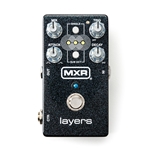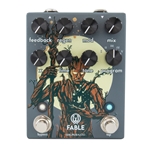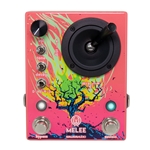Your shopping cart is currently empty.
Pitch, Harmonizer, Filter
-
 Electro-Harmonix Pitch Fork Polyphonic Pitch ShifterThe Pitch Fork transposes an instrument’s pitch over a +/- three octave range and features three modes which allow the pitch to be transposed up, down or both, simultaneously. The pitch shift amount can be set to a fixed interval or continuously varied by an expression pedal or control voltage. The controls are straightforward and intuitive. An 11-position Shift switch selects the maximum transposition interval ranging from D (Detune), a shift of 17 cents, through Minor 2nd, Major 2nd, Major 3rd, Perfect 4th, Perfect 5th, Major 6th, Minor 7th, 1 Octave, 2 Octaves and 3 Octaves. A three position toggle switch controls whether the pitch is transposed up, down or both. In Dual mode, two pitch-shifted signals are output. One follows the shift knob as if in the Up position while the other creates a harmony. Dual Mode settings include M3 up + P5 up, P5 up + 1 Oct down, 1 Oct up + 1 Oct down and many others. A Blend knob controls the mix of the dry signal and the effected signal, and an EXP jack enables the player to control pitch and glissando with an expression pedal. The Latch button selects Latch or Momentary mode which affects how the footswitch and EXP input behave. In Latch mode, the footswitch toggles between effect on and buffered bypass each time it’s pressed and the EXP input continuously varies pitch. In Momentary mode the effect is only on while the footswitch is depressed and when it is released the Pitch Fork goes into bypass. In Latch mode the EXP input controls pitch shift amount, ranging from unity to the interval set by the Shift knob, and pitch varies continuously throughout the expression pedal’s range. In Momentary mode the EXP input controls glissando rate for the Pitch Fork’s footswitch. When the bypass footswitch is pressed, the Pitch Fork jumps from bypass to the interval set by the Shift knob. The amount of time it takes to reach that new note is the glissando rate. When the footswitch is released the pitch will return to unity at the same rate. That glissando time can vary between 4 milliseconds to two seconds depending on the heel/toe position of the expression pedal. The default glissando rate is 60 milliseconds when nothing is plugged into the EXP input. The Pitch Fork comes equipped with an EHX 9.6DC-200mA power supply and also runs on a 9Volt battery.
Electro-Harmonix Pitch Fork Polyphonic Pitch ShifterThe Pitch Fork transposes an instrument’s pitch over a +/- three octave range and features three modes which allow the pitch to be transposed up, down or both, simultaneously. The pitch shift amount can be set to a fixed interval or continuously varied by an expression pedal or control voltage. The controls are straightforward and intuitive. An 11-position Shift switch selects the maximum transposition interval ranging from D (Detune), a shift of 17 cents, through Minor 2nd, Major 2nd, Major 3rd, Perfect 4th, Perfect 5th, Major 6th, Minor 7th, 1 Octave, 2 Octaves and 3 Octaves. A three position toggle switch controls whether the pitch is transposed up, down or both. In Dual mode, two pitch-shifted signals are output. One follows the shift knob as if in the Up position while the other creates a harmony. Dual Mode settings include M3 up + P5 up, P5 up + 1 Oct down, 1 Oct up + 1 Oct down and many others. A Blend knob controls the mix of the dry signal and the effected signal, and an EXP jack enables the player to control pitch and glissando with an expression pedal. The Latch button selects Latch or Momentary mode which affects how the footswitch and EXP input behave. In Latch mode, the footswitch toggles between effect on and buffered bypass each time it’s pressed and the EXP input continuously varies pitch. In Momentary mode the effect is only on while the footswitch is depressed and when it is released the Pitch Fork goes into bypass. In Latch mode the EXP input controls pitch shift amount, ranging from unity to the interval set by the Shift knob, and pitch varies continuously throughout the expression pedal’s range. In Momentary mode the EXP input controls glissando rate for the Pitch Fork’s footswitch. When the bypass footswitch is pressed, the Pitch Fork jumps from bypass to the interval set by the Shift knob. The amount of time it takes to reach that new note is the glissando rate. When the footswitch is released the pitch will return to unity at the same rate. That glissando time can vary between 4 milliseconds to two seconds depending on the heel/toe position of the expression pedal. The default glissando rate is 60 milliseconds when nothing is plugged into the EXP input. The Pitch Fork comes equipped with an EHX 9.6DC-200mA power supply and also runs on a 9Volt battery.
- Transposes over a +/- three octave range
- Three shift modes: up, down or dual
- 11-position Shift knob selects the transposition interval
- EXP input lets you control pitch shift or glissando via optional expression pedal
- Latch and Momentary modes affect how the footswitch and EXP input behave
- Comes with EHX 9.6DC-200mA AC Adapter, can also run off a 9V battery
- Dimensions in inches: 2.75 (w) x 4.5 (l) x 2.1 (h)
- Dimensions in mm: 70 (w) x 115 (l) x 54 (h)
Regular Price: $250.60Guaranteed Best Price: $197.80 -
 MXR Layers Transcendental Sustain EffectThe MXR Layers Pedal blooms with rich, organic sustain that imbues every strum and pluck with resonance and depth—pull off chord voicings you never thought possible, compose transcendent melodies, orchestrate harmonic ensembles, create lively stereo pads, and more—all from a standard MXR housing.
MXR Layers Transcendental Sustain EffectThe MXR Layers Pedal blooms with rich, organic sustain that imbues every strum and pluck with resonance and depth—pull off chord voicings you never thought possible, compose transcendent melodies, orchestrate harmonic ensembles, create lively stereo pads, and more—all from a standard MXR housing.
The MXR Layers Pedal will confer its expertly created sustain and natural decay to up to three layers, each with its own mini LED to tell you its active. First, decide if you want to run just a single layer or up to three—engaging the Single switch keeps it to one. Layers can be triggered both with the footswitch and through your playing dynamics. With the footswitch, you just play a note or chord and hold the switch down—releasing the switch will allow the layer to fade according to your Decay knob setting. This is perfect for composing complex solos over droning accompaniments. Alternatively, you can trigger layers automatically in response to your attack, as set by the Trig knob. Combine these two methods for more creatively complex sound stacking: with Single mode disengaged, you can hold a layer with the footswitch and then auto-trigger more layers over top.
The MXR Layers Pedal offers a straightforward set of controls to tailor your layers to taste. The Mix knob adjusts the wet signal level; in other words, the volume of your layers. As previously stated, the Trig knob sets the sensitivity of the pedal’s auto-trigger function, allowing you to generate new layers according to the intensity of your pick strokes. The Attack knob adjusts the fade-in time of each layer, while the aforementioned Decay knob sets the fade-out time, which mimics the natural vibrations of a physical string by decaying the high frequencies first. For a fat subterranean vibe, engage the Sub Oct switch to take one or more of your layers down an octave.
Delving beyond the core features, the MXR Layers Pedal offers the experimentally inclined even more intricate opportunities to customize not only the sound of your layers but the overall playing experience. Through the pedal’s programming functions, you can adjust additional parameters, including modulation intensity, delay time, diffusion, and more. You can also use your keyboard’s sustain pedal or another off-board switch such as the MXR Split + Tap to trigger your layers, blend setting configurations with the Volume(X)™ 8 Pedal, and run Stereo Input, Stereo Output, and Dry/Wet Split modes.Price: $245.99 -
 Walrus Audio Fable: Granular Soundscape GeneratorIn the high woodlands of the north, undiscovered by most inhabitants, there ruled a clan of old, mystic Treefolk. On the first new moon of spring, these Treefolk could be heard grafting limbs to grow their young - splicing bits of branches from each generation to produce the next line of Treefolk. These new beings keep the lifeblood of all who came before in their new skin. These sounds are in part very old but in part very new. They are referred to as… Fable.
Walrus Audio Fable: Granular Soundscape GeneratorIn the high woodlands of the north, undiscovered by most inhabitants, there ruled a clan of old, mystic Treefolk. On the first new moon of spring, these Treefolk could be heard grafting limbs to grow their young - splicing bits of branches from each generation to produce the next line of Treefolk. These new beings keep the lifeblood of all who came before in their new skin. These sounds are in part very old but in part very new. They are referred to as… Fable.
Let your storybook adventure grow with the Fable Granular Soundscape Generator. The Fable creates new sonic adventures with five granular delay programs centered around sample and chop algorithms. The Fable generates its wonder with a dual feedback path developed by DSP engineers at Walrus Audio. With two DSP chips, your signal is run through two separate effects in series (independently controlled by the Feedback and Regen Knobs), then the signals are run back through both DSP chips again before going through the output. What does that mean? Artists will discover unique soundscapes ranging from smooth, flowing ambience; to bizarre, organic reverberance; to chaotic, glitchy swarms.
What exactly is this granular effect and why is it a magical experience when combined with delay? Granular is a digital processing technique of micro-sampling, wherein short samples called grains are read from a delay buffer. In the Fable, players can adjust these grains by manipulating their sampling length, position, and buffer size from which they’re read. They can be played at double or half speed for pitch shift and time stretching effects, play them in reverse, read from multiple positions, and more, to achieve different effects.
It’s a powerful but complex technique and we’ve created five streamlined programs in the Fable that explore different aspects of its sonic range.
Programs
I. Reverse Delay into Reverse Granular
Program 1 runs a reverse delay into a reverse granular algorithm, in which sampled grains are played backwards. Reversal and re-reversal build up in the feedback paths, creating a complex and organically shifting soundscape. Turn grain size down for long, smooth reversed transients, and grain size up for stuttering reverse glitch madness.
II. Forward Delay into Octave Up Granular
Program 2 runs a forward delay into an octave-up granular program, in which sampled grains are played at double speed. Swarms of double-speed grains build up in the feedback path for bright and airy cascades of sound.
III. Analog-Style Delay into Octave Down Granular
Program 3 runs a warm, dark analog-style delay into an octave-down granular program, in which sampled grains are played back at half speed. Slowed down repeats combined with analog-style processing to create deep, thunderous footfalls and thick, murky ambience.
IV. Multi-Tap Granular into Multi-Tap Granular (Grain-Verb)
Program 4 runs two multi-tap granular algorithms in series, in which multiple samples are played back from each granular buffer simultaneously. Multiple points of sampled sound build upon each other in the feedback paths to create glitchy clouds and unique organic reverberance. Time in this program controls time-stretching of both granular algorithms, changing both the length and tonal character of the granular effect.
V. Forward Delay into Randomized Pitch Granular
Program 5 runs a forward delay into a randomized pitch granular program, in which each grain is played back at a randomly selected speed and direction, varying between pitched up double speed, pitched down half speed, normal speed, plus forward and reversed playback from grain to grain. Pitch changes with each new grain, so play with the X knob in this program to control the rate of randomized pitch modulation.
Price: $299.99 -
 Walrus Audio Melee: Wall of NoiseWe give you the two most quintessential effects that yield unruly amounts of power and influence to an instrumentalist: reverb and distortion. They have been harnessed and woven together for an eternity of ethereal power with The Melee: Wall of Noise. The Melee unapologetically uses a joystick to meld reverb and distortion into one massive blaze of sound. With the flip of the order switch, run the distortion into the reverb or reverb into distortion; signal chain is your call now. For the explorer, the Melee can run one of three different reverb programs Ambient, Octave, and Reverse.
Walrus Audio Melee: Wall of NoiseWe give you the two most quintessential effects that yield unruly amounts of power and influence to an instrumentalist: reverb and distortion. They have been harnessed and woven together for an eternity of ethereal power with The Melee: Wall of Noise. The Melee unapologetically uses a joystick to meld reverb and distortion into one massive blaze of sound. With the flip of the order switch, run the distortion into the reverb or reverb into distortion; signal chain is your call now. For the explorer, the Melee can run one of three different reverb programs Ambient, Octave, and Reverse.
In a less is more approach, we’ve intentionally decided on controls that are fun to use and will inspire a wealth of creative output. Use the joystick to control the amount of distortion by moving it up and down. Moving the joystick left and right will adjust your reverb mix. The tone and decay toggles have low, medium, and high settings. Modulation can be added to the wet signal by holding down the bypass switch and moving the decay toggle. The left position is no modulation, the middle is a slight modulation, and the right is a high modulation.
ALGORITHMS
The Melee is equipped with three different reverb programs, which can be changed by simultaneously pressing the bypass and sustain stomp switches. Experiment with the order toggle switch to hear how differently these all react in front and after the distortion!
• Ambient Reverb (Pink LED) - Huge reverb capable of massive trails and engulfing your chords into an angry wash of sound. Great for soaring melodic lines or shoegaze-driven chord progressions.
• Octave Down Reverb (Yellow LED) - Similar to the Dark mode in the Slö, you’ll find an eerie lower octave hovering in the reverb trail for a nice and dark atmospheric touch.
• Reverse Reverb with Feedback (Blue LED) - Add reversed reverb trails back into your signal, create gentle melodies or push into reverse feedback overload. Big, slow, and sad chords love to hang out here.
MOMENTARY
Press and hold the sustain switch to ramp up the reverb trails. Release and the trails will ramp back down to where the decay switch is currently set. The sustain switch can also latch in all three programs. Press and release the Sustain switch to capture and sustain the current reverb decay for long pad-like sounds in your wet mix. Press again to release the latch, and the reverb trail will taper off based on the position of the decay knob.
Price: $299.99
